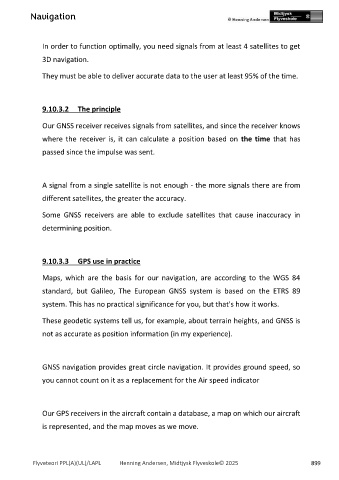Page 899 - PPL-engelsk 2025
P. 899
Navigation
In order to function optimally, you need signals from at least 4 satellites to get
3D navigation.
They must be able to deliver accurate data to the user at least 95% of the time.
9.10.3.2 The principle
Our GNSS receiver receives signals from satellites, and since the receiver knows
where the receiver is, it can calculate a position based on the time that has
passed since the impulse was sent.
A signal from a single satellite is not enough - the more signals there are from
different satellites, the greater the accuracy.
Some GNSS receivers are able to exclude satellites that cause inaccuracy in
determining position.
9.10.3.3 GPS use in practice
Maps, which are the basis for our navigation, are according to the WGS 84
standard, but Galileo, The European GNSS system is based on the ETRS 89
system. This has no practical significance for you, but that's how it works.
These geodetic systems tell us, for example, about terrain heights, and GNSS is
not as accurate as position information (in my experience).
GNSS navigation provides great circle navigation. It provides ground speed, so
you cannot count on it as a replacement for the Air speed indicator
Our GPS receivers in the aircraft contain a database, a map on which our aircraft
is represented, and the map moves as we move.
Flyveteori PPL(A)(UL)/LAPL Henning Andersen, Midtjysk Flyveskole© 2025 899

